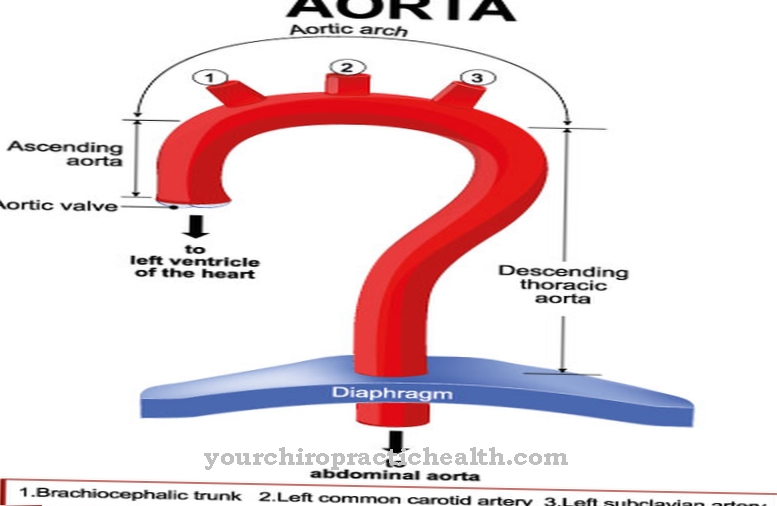As Pulmonary stenosis is a narrowing of the outlet from the right ventricle or the pulmonary artery valve, which is classified according to severity.
What is pulmonary stenosis?

© Edward - stock.adobe.com
A Pulmonary stenosis is a constriction in the outflow path between the right ventricle and the pulmonary artery. The pulmonary valve is located between the pulmonary artery and the right ventricle. The oxygen-poor blood reaches the lungs through them. So the flap is a valve that is responsible for controlling blood flow. It is a congenital heart defect that either occurs in isolation or can be part of a complex heart defect.
A total of three different types of pulmonary stenosis can be distinguished:
- Subvalvular pulmonary stenosis: Narrowing of the outlet from the right ventricle due to excess tissue
- Valvular pulmonary stenosis: Affects the valve itself, whereby the valve pocket is partially fused or thickened and the valve opening is not complete.
- supravalvular pulmonary stenosis: narrowing above the valve and narrowing of the pulmonary artery
The most common type is valvular pulmonary stenosis, which affects more than 90 percent of cases.
causes
In many cases, pulmonary stenosis is a congenital heart defect and the causes are not known. Under certain circumstances, however, a genetic predisposition can be held responsible. It is also possible that the pulmonary valve is not fully developed during pregnancy. Pulmonary stenosis can also occur in addition to a congenital heart defect or as part of a rheumatic fever or cancerous tumors in the digestive tract.
Symptoms, ailments & signs
The symptoms of pulmonary stenosis vary widely and depend on the severity of the narrowing. If the constriction is only very slight, there are usually no symptoms. In severe cases, there is difficulty breathing (dyspnea), which can be observed especially when the heart is stressed. In addition, those affected suffer from peripheral cyanosis, which means that the patients are not adequately supplied with oxygen.
The heart is unable to carry enough deoxygenated blood to the lungs. As a result, the red blood cells, which are responsible for transporting oxygen and exchanging it for carbon dioxide, do not receive any new oxygen. Thus it is not possible for them to give off the carbon dioxide. Peripheral cyanosis can be detected with the help of a blood test, whereby the level of carbon dioxide in the red blood cells is greatly increased.
Trying to pump blood through the valve is an extremely strenuous effort on the heart. As a result, the blood presses on the heart muscle, which grows as it has to adapt to the pressure conditions. If the narrowing of the heart valve is very strong, heart failure can also occur. Other possible symptoms are fatigue, protruding stomach, fainting, and a bluish tinge of the skin.
Diagnosis & course of disease
Pulmonary stenosis can be diagnosed in different ways. First, the doctor listens to the person concerned with a stethoscope. As a result, he hears the heart tones, whereby in the case of pulmonary stenosis a so-called split second heart tone can be heard, which is due to the narrowing. A noise called a "systolic" may also be heard as the blood flows out of the ventricle.
An EKG is also very often performed, and changes can be seen in the event of a severe narrowing. Another examination method is the echocardiogram. This is an ultrasound scan that allows the doctor to visualize the structure of the heart. The heart or the heart valves can be viewed on a monitor and the direction of blood flow can be determined with the help of a color Doppler.
An enlarged right heart can also be seen on an x-ray. The pulmonary vessels, on the other hand, are only shown very weakly, which is a sign that only little blood is transported through the constricted heart valve into the lungs. A so-called invasive method is a right heart catheter, which can provide very precise information about a possible heart defect. With the help of a catheter it is possible to estimate the severity of the constriction. To do this, the doctor inserts a catheter into a vessel on the thigh and then pushes it forward to the heart, where the catheter tip can measure the pressure conditions in the pulmonary artery or the heart chambers.
Complications
Due to pulmonary stenosis, those affected in most cases suffer from heart problems or breathing difficulties. At the same time, the resilience of those affected by the disease drops significantly and the patient becomes permanently tired and exhausted. The internal organs are also supplied with less oxygen due to the pulmonary stenosis and can be damaged as a result.
In the worst case scenario, those affected will also be poisoned with carbon dioxide. Since the heart also has to carry an increased amount of blood, heart failure or other heart conditions can occur. In the worst case, the affected person dies of heart failure. As a rule, the patient's life expectancy is significantly reduced without treatment. This disease can be treated with surgery.
There are no particular complications. However, the person concerned can no longer perform strenuous activities or sports. Furthermore, the patient is also dependent on medication to prevent further complaints. With successful treatment of pulmonary stenosis, life expectancy is in most cases unaffected. A healthy lifestyle can also have very positive effects on this disease.
When should you go to the doctor?
Pulmonary stenosis must always be treated by a doctor. In the worst case, the affected person can die, so that early diagnosis and treatment always have a very positive effect on the further course of the disease. As a rule, pulmonary stenosis is characterized by shortness of breath. In particular, strenuous activities or sporting activities can lead to shortness of breath, and the person affected can also completely lose consciousness. Cyanosis can also indicate pulmonary stenosis and should be investigated if it occurs over a long period and reduces the patient's quality of life. Persistent tiredness or a protruding stomach also indicates the disease and must be examined by a doctor.
Primarily, the disease can be examined by a general practitioner or by a cardiologist. However, if there is an emergency or loss of consciousness, an emergency doctor should be called or the hospital should be visited.
Therapy & Treatment
A frequently chosen method for the treatment of pulmonary stenosis is widening the narrowed heart valve with the help of a balloon. The balloon is placed at the same level as the pulmonary stenosis using a cardiac catheter and then inflated. This allows the changed heart muscle to regress. In the case of very severe stenoses, however, an operation may also be necessary.
As part of this operation, the pulmonary valve is reconstructed or a heart valve is inserted. Newborns who suffer from severe pulmonary stenosis require intensive medical care. The doctor may also prescribe medication that will help the blood flow more easily. These include, for example, medication for cardiac arrhythmias, water pills to enable increased water excretion, blood thinners and prostaglandins that improve blood circulation.
prevention
Since pulmonary stenoses are very often congenital heart defects, they cannot be prevented. Those affected should lead a heart-friendly and healthy lifestyle and avoid cigarettes. A healthy diet and regular exercise are also important.
Aftercare
The various degrees of severity and causes of pulmonary stenosis lead to different forms of therapy. The spectrum of possible treatments ranges from a change in diet to balloon dilatation, the insertion of a stent and an operative replacement of the pulmonary valve in the right ventricle. The need for aftercare treatments and examinations is correspondingly differentiated.
Based on a milder form of pulmonary stenosis, there is above all the need for follow-up examinations. This is used to determine whether the severity of the stenosis has decreased permanently or whether the disease is progressing, so that further treatment or a surgical procedure is indicated. The most important diagnostic devices for follow-up examinations are the stethoscope, EKG and the Doppler ultrasound machine.
Regular follow-up examinations are also recommended after balloon dilatation or an endoprosthetic replacement of the pulmonary valve. As a follow-up examination, Doppler sonography is of particular importance. It can thus be tracked whether a thickening of the heart wall of the right ventricle (hypertrophication) regresses, which can be seen as an indication that the intended therapeutic purpose has been achieved.
As a check-up, further follow-up examinations are recommended from time to time, since a renewed narrowing of the pulmonary valve often initially occurs without symptoms. There is a risk that the renewed constriction of the pulmonary circulation will not be noticed until very late, which can make subsequent therapy more difficult.





.jpg)


















.jpg)



